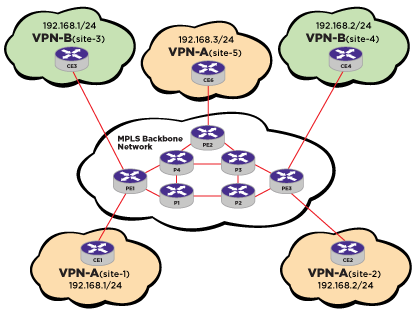Overview of Layer 3 VPN
Layer 3 Virtual Private Networks (L3VPN) is a specific implementation of PPVPN (Provider Provisioned VPN). L3VPN is a way to create a tunnel between customer sites through a Provider Backbone, and that tunnel is established and maintained by the Service Provider.
Within a Layer 3 VPN, the customer advertises IP routing knowledge to the provider network. The ISP then advertises this routing information across its network to the other customer locations. This simple concept requires some coordination between the provider and the customer. Also, the provider must configure its network to support the advertisement of these routes and have a way to segregate the customer routes. This is accomplished with the help of a specially designed Network Layer Reachability Information (NLRI).
Within a L3VPN, several routers will play a different role. On the customer site, there is a CE router (Customer Edge). This router is the property of the customer and is managed by them. This router is outside of the Autonomous System (AS) of the Provider. On the Provider side there are some PE routers (Provider Edge) and P routers (Provider). The PE routers are facing the CE routers. They have all the customer's IP routing knowledge. The P routers do not have that knowledge; they are not facing any CE routers, and they serve only to transport the data from PE routers to other PE routers. Their knowledge is very limited, and they usually are intended only for swapping MPLS labels. In other words the Provider‘s core is pure MPLS and has no knowledge of L3VPN, while the edge is L3VPN aware.

A L3VPN requires an MPLS transport mechanism in the Provider Backbone for the data forwarding and Multiprotocol BGP (MBGP) between the PE routers to exchange VPN-IPv4 routing information.

